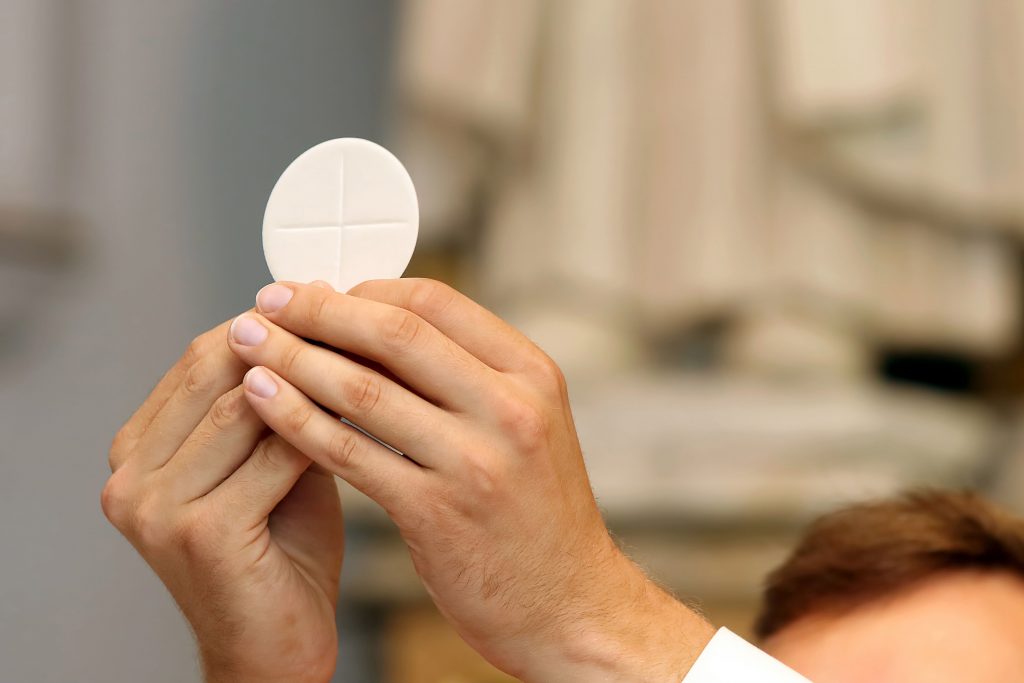The Communion Rite at Mass consists of six distinct moments:
> Lord’s Prayer
> Rite of Peace
> Fraction Rite
> Sharing in Communio
> Quiet prayer after Communio
> Prayer After Communio
It is beneficial that every year pastors and parish liturgy committees review the General Instruction of the Roman Missal (GIRM) Nos. 80-89 and reflect on the manner in which the community celebrates this time in the Mass This article could serve as an outline for your reflection.
> With our “Amen” that ends our Eucharistic Prayer, the Communion Rite begins. The priest-presider invites the community to join in the Lord’s Prayer. At the end he adds a final petition called the embolism (“Deliver us, Lord……”). The whole assembly finishes the prayer with the doxology: “For the kingdom, ….”
> “There follows the Rite of Peace, by which the Church entreats peace and unity for herself and for the whole human family. … It is appropriate that each person … offer the sign of peace only to those who are nearest.” (GIRM 82)
> When the sign of peace is completed, the presider breaks the Eucharistic Bread. This moment, known as the Fraction Rite is not just a religious act that fulfills a function. “The gesture of breaking bread done by Christ at the Last Supper, which in apostolic time gave the entire Eucharistic Action its name, (Fraction Rite) signifies that the many are made one body (1 Cor 10:17) by receiving Communion from the one Bread of Life which is Christ. … The fraction … is carried out with proper reverence, and should not be unnecessarily prolonged.” (GIRM 83)
The invocation of the Lamb of God or Agnus Dei accompanies the fraction rite. Every parish needs to examine how they handle the transition from Sign of Peace to Fraction Rite. Too often, without awareness, members of the assembly continue the sign of peace, while the presider has begun breaking the bread. The two moments mistakenly overlap. Care needs to be taken that each movement of prayer is understood by the whole assembly and not reduced in significance. As we can see by the comment in the GIRM 83 above, in the history of our liturgical tradition the Fraction Rite is not merely functional.
> Here’s another important detail: “It is most desirable that the faithful, just as the priest himself is bound to do, receive the Lord’s body from hosts consecrated at the same Mass and that, in the cases where this is foreseen, they partake of the chalice.” (GIRM 85)
In other words, going to the tabernacle for the reserved sacrament (hosts consecrated at a previous Mass) is done only when necessary, not as a regular practice. This can present some complicated planning, but it is not impossible, and we are, in fact required by No. 85 to do whatever is necessary to ensure that this happens.
Also, GIRM 86 instructs us to sing during the communion procession: “While the priest is receiving the sacrament, the Communion chant is begun, its purpose being to express the spiritual union of the communicants by means of the unity of their voices, to show gladness of heart, and to bring out more clearly the ‘communitarian’ character of the procession to receive the Eucharist.”
The singing during the communion procession is not for musical enhancement. Song is integral to the spiritual significance of the moment: one body, one voice. Notice, it begins while the presider is partaking of communion, not after, and continues until all have partaken.
GIRM 96, “Functions of the People of God,” reminds us: “… they are to form one body, whether by hearing the Word of God, or in taking part in the prayers and in the singing, or above all by the common offering of the sacrifice and by participating together at the Lord’s Table. This unity is beautifully apparent from the gestures and bodily postures observed together by the faithful.”
In the Archdiocese of Los Angeles, our 1997 pastoral letter on liturgy — “Gather Faithfully Together” — instructs us that the entire assembly is to remain standing throughout the communion procession. We do not sit until everyone has shared in communion. Our unity is further expressed in our common gestures and postures at liturgy.
> “When the distribution of Communion is over, if appropriate, the priest and faithful pray quietly for some time.” (GIRM 88)
> The Prayer After Communion brings the entire Communion Rite to a close. It is not a final prayer to the whole Mass. The Concluding Rites of the Mass follow after this prayer: “To bring to completion the prayer of the People of God, and also to conclude the whole Communion Rite, the priest pronounces the Prayer After Communion. … The people make the prayer their own by means of the acclamation: Amen.” (GIRM 89)
In conclusion: “There should be harmony and diligence among all those involved in the effective preparation of each liturgical celebration in accordance with the Missal and other liturgical books.” (GIRM 111)

